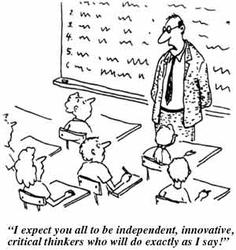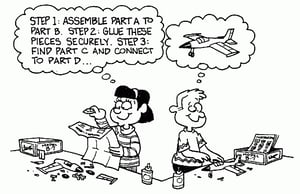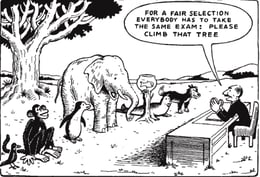“There has to be a better way!” I remember a character on a movie or TV show I watched as a youngster constantly repeating this phrase and it’s been ingrained in my mind ever since. There’s a chance I’m making this up and such a character with this common refrain does not in fact exist, but go with me for a second. Searching for a better way to do things has fueled my work and my passion for design — not “capital D design” but design in a more general sense. I’ve always loved making things, but it’s not the final product that gets me the most excited, it’s the pursuit to get there. When I think about the word “creation,” I prefer the verb to the noun.
The design process empowers designers and creators to ask the question, “What if?” What if school didn’t have to happen in a physical building? What if students had more ownership over when and how they learned? What if the community could function as an extension of the learning space? These three questions and hundreds more have been put to a very real test over the past several months as schools and communities have grappled with the many design challenges that have accompanied school’s shift to a COVID-19 world.
While I could probably spend hours discussing the process of design and the abilities we strengthen within ourselves through the design process (perhaps in a future blog post), I want to specifically focus on why design matters right now. Moreso, how might we leverage universal design principles to provide equitable, student-centered learning experiences in an increasingly complex and uncertain world?
Let’s start at the beginning. The 7 Principles of Universal Design were first developed by Ron Mace and a group of design researchers and practitioners across the United States and published in 1997 by North Carolina State University. These principles were created to “evaluate existing designs, guide the design process, and educate both designers and consumers about the characteristics of more usable products and environments.”
- Equitable Use
- Flexibility in Use
- Simple and Intuitive
- Tolerance for Error
- Perceptible Information
- Low Physical Effort
- Size and Space for Approach and Use
An important consideration in universal design in a broad sense is crafting solutions that live “at the margins” — particularly for those who are underserved by a “traditional” solution to a particular problem. When we design for those extreme use cases, it turns out, what results is better for all users of that particular product or experience. Take a doorway to a building, for example. If the only way to open or close that door is with a standard doorknob, a wide variety of people might not be able to get through because of variations in physical ability. If we were to design a new doorway specifically for someone who could not use their arms (a small subsection of people or extreme use cases), however, we might opt for an automatic door that opens and closes with a sensor. In this case, it turns out the design enhances the experience for someone with limited mobility and for someone without physical limitations. This new solution, which is simple and intuitive, is equitable and flexible in use, and requires low physical effort, turns out to be a better solution for everyone.
You might say that as educators, we’re in a perpetual state of building doorways, ramps, staircases, and elevators to help our students get from where they are to where they want to be. As architects of learning experiences and environments, it is in our best interest to create solutions for our students that apply the same universal design principles.
In The End of Average, Todd Rose explains, “the moment you need to make a decision about any individual, the average is useless. Worse than useless, in fact, because it creates the illusion of knowledge, when in fact the average disguises what is most important about an individual.” When we translate this notion into the classroom, it’s clear that variability among learners is the rule, not the exception. One would be hard-pressed to identify a single approach or solution that works equally as effectively for all students. A single doorway doesn’t do the trick.
The Universal Design for Learning (UDL) — developed by the Center for Applied Special Technology, now CAST — is a neuroscience-backed framework for educators and designers of learning experiences to incorporate universal design into the teaching and learning experience. This framework is aligned to activating specific portions of the brain related to the “why,” “what,” and “how” of learning. At its core, a learning experience that is universally designed provides for multiple means of engagement, representation, and expression for all learners. UDL operates with the understanding that there is no one means of engagement, representation, and expression that is optimal for all learners. Therefore, we must intentionally create multiple ways for students to experience and participate in their learning environment.

|
Engagement: Allowing students a variety of ways to engage in learning material allows us to create learning experiences that enable them to feel purposeful and interested in their learning. Learners are motivated in a number of different ways and bring with them their own sets of passions and interests that, when leveraged, can lead meaningful learning experiences. How might we tap into those interests to spark students’ curiosity, incentivize self-regulation, and unlock sustaining effort and persistence? |

|
Representation: Multiple means of representation relates to the ways that designers of learning experiences vary the ways that they present material to learners. A common misconception around learning styles is that individuals have a style(s) that work best for their learning (e.g., “I’m a visual learner”). Rather, individuals have different learning abilities, not styles per se. Daniel Willingham, a psychologist at the University of Virginia, argues “it’s much better to think of everyone having a toolbox of ways to think, and to think to yourself [in a particular situation], which tool is best?” Given the understanding that students differ significantly in the ways they perceive and comprehend information, how might we expose them to their toolbox of learning abilities and help them decide when and how to use particular strategies in different contexts? |
 |
Expression: Expressing and acting upon learning in multiple ways provides learners the opportunity to navigate a learning environment and show what they know. Often, we offer students options to showcase their knowledge through a written report or slideshow presentation for a summative assessment. While these can be relatively simple to administer and assess, could there be additional ways for students to demonstrate their learning more meaningfully? How might we tap into what excites students to make the assessment process more enjoyable, and a station along the ongoing learning journey versus terminus? |
There couldn’t be a more opportune time to start taking UDL seriously again. The past few months of unrest, uncertainty, and unknowns have opened our eyes to situations that we might not previously have wanted to acknowledge. For those of us who eat, sleep, and breathe what’s new and what’s next for our classrooms and schools, this comes as no surprise. But for many, 2020 has been the first time that we have become acutely aware of the sheer caliber of inequities that exist within systems that are oft taken for granted. The default mentality might be to just write off the last semester and start over next year. But as my favorite Peloton instructor, Robin Arzon, put it: “2020 isn’t canceled. It’s when we woke up.” Now is the time to reimagine the learning experience for all students, and UDL can help us do that in three specific ways.
Responsive Classrooms
Regardless of what the classroom looks like, UDL offers us opportunities to make the learning experiences we craft for students more responsive to, and reflective of, their needs. As we plan to return to school in the fall, the question we should be asking ourselves is not “what gaps do we need to fill?” but rather, “where are students right now?” How can we be the most responsive to student needs where they are currently, and how can we leverage their voice, strengths, learning abilities, and interests to get them to where they want to be?
Equity
“Every system is perfectly designed to get the results that it gets.” This quote (which can be attributed to a number of thinkers) is reflective of the collective wake-up call many of us have received over the past several months. Many of the systems and structures in which we have been operating in K-12 education were designed inequitably. Our job now is to dismantle those systems and omit oppressive power structures, remove rhetoric rooted in racism, and eliminate processes that don’t support equity. The UDL framework, by design, was intentionally created to promote equitable learning environments. The word “universal” was selected because curriculum and associated learning experiences should honor and reflect all learners’ backgrounds, strengths, needs, and interests. Not some. Not most. All.
Student-Centered
Whether you call it personalized, blended, or competency-based learning, the future of learning is student-centered. This all-encompassing term promotes the idea that learning should be driven by the student and guided by the expertise of educators. UDL allows us to achieve this vision for a student-centered future of leaning by offering multiple ways for students to participate in the learning process and giving them the voice and choice to select the tools and methods that work best for them. Universal design provides options that meet the needs of all learners, and all learners are empowered to make their own decisions.
Call to Action: We put together this resource to give you some practical strategies for how to leverage UDL in your virtual classroom to maximize student engagement. As you look through this guide, think about some small steps you can take to make learning experiences in your classroom or your school more responsive, equitable, and students centered through the UDL framework. Let me know what you come up with in this VideoAsk!
Check out some more of my thoughts on the subject in Episode 1 of A Dose of Design with Drew!
-1.jpeg)



